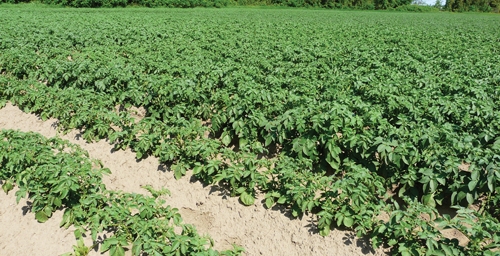
Features
Chemicals
Seed Treatment
What makes chloropicrin a good pick?
The variety of soil pathogens keep potato growers busy mitigating their potential crop damage, but a product that has been around for nearly a century is becoming more welcome in fields. Chloropicrin has a long track record of effectiveness on many soil-borne pathogens, including verticillium wilt, scab, Colletotrichum (black dot), rhizoctonia, fusarium, and phytophthora. First used on pineapples in Hawaii, the product is making its way into Canada’s potato fields.
“Chloropicrin could be one of the more expensive inputs, but our market would not be growing in Canada if growers were not getting a benefit from using it,” observes Dr. Chad Hutchinson of TriEst Ag Group, Inc., the North Carolina-based distributor of chloropicrin. Since its introduction to Canada in 2000, the soil fumigant has gained fans in Ontario, Quebec, and Nova Scotia. It is now being tried on potatoes in Manitoba.
June 10, 2013 By Rosalie I. Tennison
 Successful field use of chloropicrin. The bottom left two rows are part of the check plot. The variety of soil pathogens keep potato growers busy mitigating their potential crop damage
Successful field use of chloropicrin. The bottom left two rows are part of the check plot. The variety of soil pathogens keep potato growers busy mitigating their potential crop damage“This product has been around long enough that it has a proven track record,” Hutchinson adds. Chloropicrin is marketed by TriEst as PicPlus, a blend of 86.5 per cent chloropicrin and a proprietary solvent that minimizes volatilization.
First identified as a scab-fighter by Ontario Ministry of Agriculture, Food and Rural Affairs potato specialist, Dr. Eugenia Banks, chloropicrin has impressed Ontario growers with how it reduces scab pressure, thereby leaving tubers much more marketable. The product is injected and packed into the row in the fall and a cover crop can be planted over it. In the spring, the cover crop is desiccated and potatoes can then be planted. If applied in the spring, potatoes should not be planted for three weeks after chloropicrin goes in the ground.
“Chloropicrin controls the organisms that limit root growth and allows for a greater root system to develop, which can more efficiently use water and withstand stress,” explains Hutchinson. “This translates into more foliage growth and improved yield.”
“There is a substantial yield increase that is related to reduced disease pressure in the field,” adds Jeff Douglas of Douglas Agricultural Services Inc. in Simcoe, ON. “By clearing up the scab in fields, the marketable yield increases. The growers who are using it see a significant yield advantage.”
Douglas says the cost per acre varies depending on transportation and delivery, but using chloropicrin will cost between $350 and $400 per acre. He says that the yield increases he has seen are between 80 and 100 cwt per acre over a variety of fields and the incidence of scab was reduced by an average of 30 per cent.
“Chloropicrin is the best product for soil-borne diseases in Canada and it is the only one that has action on scab,” Douglas says.
There is also an environmental benefit, according to Hutchinson, and add that one pound of carbon dioxide is needed to produce one pound of chloropicrin. However, two pounds of carbon dioxide is scrubbed from the atmosphere when it is used in potatoes.
“We encourage growers to use chloropicrin in test plots on their farm initially,” he continues. “We want them to see the results and then make their own decisions based on their use of the product.” He adds that very few growers who take this challenge decide the product is not for them.
A product that is tough on scab and is effective on a number of other soil-borne diseases, plus has a proven track record, is worth a look. Additionally, when used as directed, chloropicrin does improve quality and yield.
“If growers weren’t seeing a return, they wouldn’t use it,” observes Douglas.
Print this page